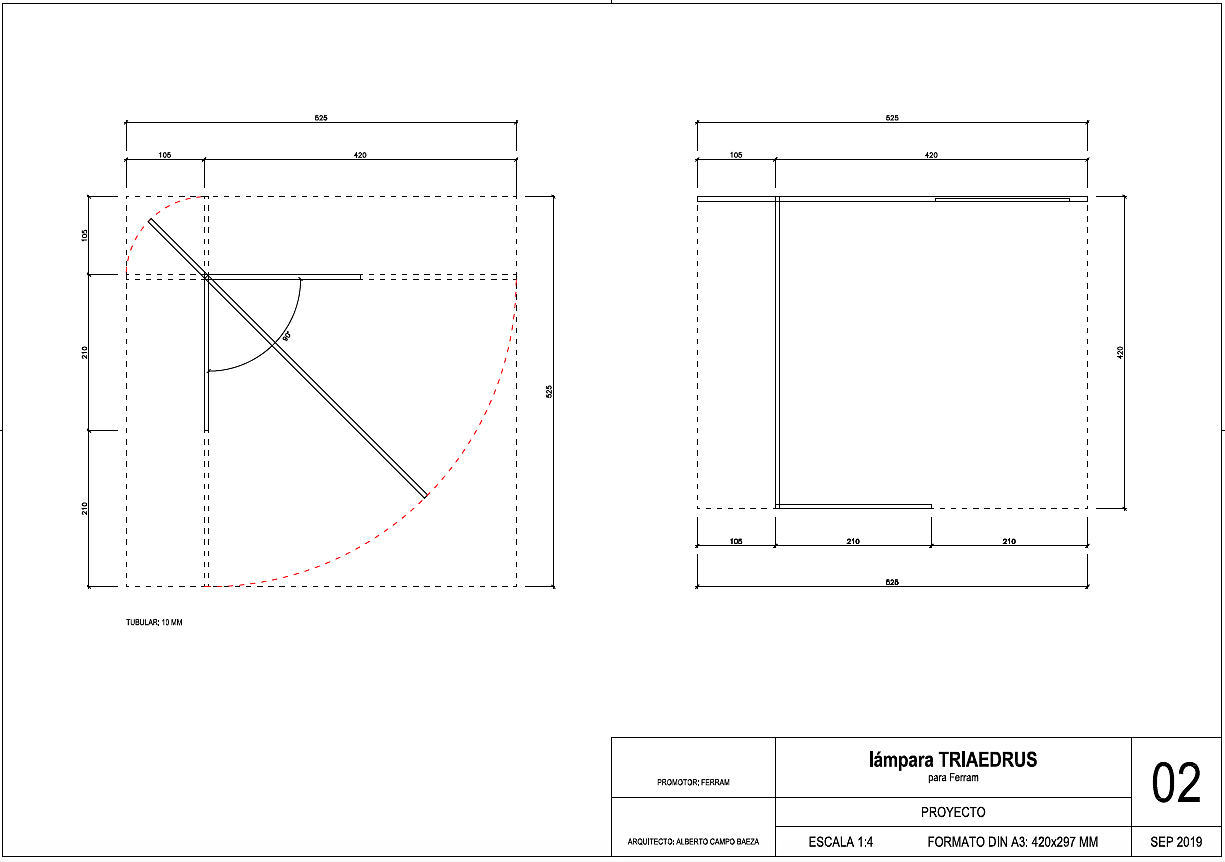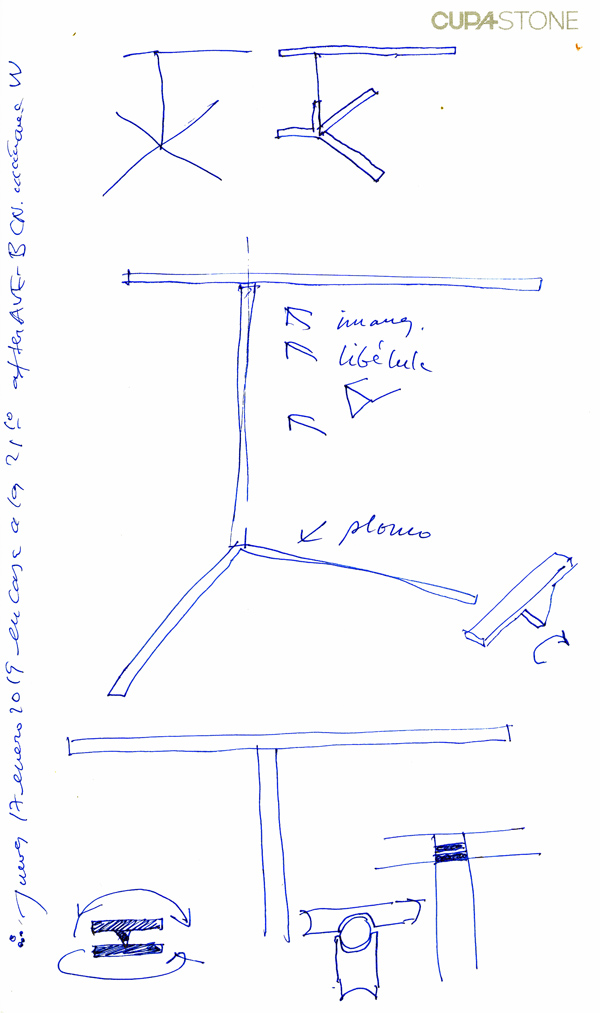Debo reconocer que, desde siempre, he soñado con hacer una lámpara. Sabiendo que una lámpara es una luz capaz de ser llevada a donde y como nosotros queramos. Controlando su situación y su intensidad.
Muchas veces había contado en clase a mis alumnos que mi lámpara era un foco de luz flotante ¿un pequeño globo luminoso blanco? capaz de cambiar de sitio y de intensidad con un mando a distancia. Como si de un globo aerostático se tratara. O mejor todavía, como una nube. Y acudí a Juguetrónica y sitios similares por ver de hacerme con un globo aerostático de juguete. Vano intento.
Y cuando aparecieron los Leds, propuse el hacer un batido de Leds, una pintura blanca de Leds, con la que pintar la cara de un Din A3 doblado de manera que se encendiera cuando se abría y se apagara cuando se cerrara. Para leer bajo su luz, apoyando el libro en la parte apagada. Me atacaron diciendo que eso ya estaba hecho y que aquello era un Lap Top.

Photo: Courtesy of Alberto Campo Baeza.

Yo casi había tirado la toalla a no ser por la insistencia de FERRAM, y su director Oscar del Río y por la insistencia de Tomás Carranza, y de Alejandro Cervilla, que trabaja conmigo. FERRAM había encargado sendas lámparas a Siza, a Souto, a Moneo, a Kazuyo Sejima y a mí. La lámpara de Souto ya está construida, y todos ellos me conminaban a que yo también la hiciera. Y con su insistencia lo han conseguido.
En arquitectura, aprendemos y enseñamos que las ideas deben ser construibles. Una idea que no pueda ser construida no tiene sentido. Los sueños deben ser realizables, construibles. Los arquitectos somos soñadores que trabajamos con líneas en vez de con palabras.

Photo: Courtesy of Alberto Campo Baeza.

Y así dibujé una línea horizontal para soportar la línea de luz de Leds a la altura precisa, y una línea vertical para soportar, para sostener en el aire esa línea horizontal. Y una articulación entre ambas líneas para hacer posible el movimiento de esa línea horizontal, de la luz, en todas las direcciones. Y el apoyo de esa línea vertical sobre el plano horizontal, sobre la mesa, ¡cómo no! también con un par de líneas en escuadra.
Hecho el primer prototipo, la maqueta, toda en tubo hueco de inoxidable mate de 1 cm de diámetro, sugería la figura de un triedro, era un triedro. Por eso decidimos llamarla TRIAEDRUS.

Courtesy of Alberto Campo Baeza.
Adenda
Debo reconocer que, tras las ideas de la lámpara nube y la lámpara papel ¡todo llegará! la inspiración me vino ante una imagen fascinante del interior de la casa estudio para Ozenfant de Le Corbusier. Un triedro maravilloso de luz que, hecho hace ya cien años, nadie se ha atrevido a repetir. TRIAEDRUS.

Courtesy of Alberto Campo Baeza.
Triaedrus: A Lamp like me
A trihedron angle is the union of three dihedral planes and the angle formed by three rays or edges. Three dihedral angles and three flat angles are formed in a trihedral angle. This is what occurs in the new TRIAEDRUS lamp, the lamp I have designed for FERRAM.

Courtesy of Alberto Campo Baeza.

I must admit to having always dreamt of creating a lamp, considering that a lamp is a light capable of being taken wherever and however we want. We control its location and its intensity.
How many times have I told my students in class that my lamp is a floating spotlight, a little white luminous globe capable of change location and intensity with a remote control? Like a hot air balloon. And I went to Juguetrónica and similar sites to try to get my hands on a toy hot air balloon. All to no avail.
And when LEDs first became available, I proposed creating a LEDs mix, a white LEDs paint, with which to paint the face of a folded Din A3, so that it would light up when it was opened and turn off when it was closed. To read under its light, leaning the book on the unlit part. My suggestion was rebuffed and I was told that this had been already done as what I was referring to was a laptop. What I was really thinking about was the possibility of painting walls and ceilings so that they would light up. Give it time.

Courtesy of Alberto Campo Baeza.


I had almost thrown in the towel but for the insistence of FERRAM and its director the architect Oscar del Río, and the insistence of two other wonderful architects: Tomás Carranza, and Alejandro Cervilla, who works with me. FERRAM had commissioned lamps from Siza, Souto, Chipperfield, Kazuyo Sejima and myself. Souto’s lamp has already been made, and they all urged me to do the same. And their persistence has paid off.
In architecture, we learn and teach that ideas must be capable of being built. An idea that cannot be built is meaningless. Dreams must be achievable, feasible. And what more logical way is there to translate this idea of a lamp than with lines? We architects are poets who work with lines as well as words.

Courtesy of Alberto Campo Baeza.



And so I drew a horizontal line to carry the line of light of the LED linear strip. And a supporting vertical line to hold that horizontal line in the air. And the articulation between both lines to enable the movement of that horizontal line, of the light, in all directions. And the support of that vertical line on the horizontal plane, on the table, with the addition, of course, of a pair of right-angled lines. Almost as if it were a feather crane. Once the first prototype was made, the scale-model suggested the figure of a trihedron, it was a trihedron. Hence the name: TRIAEDRUS.

Courtesy of Alberto Campo Baeza.










